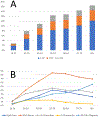Effect of Age on Opioid Prescribing, Overdose, and Mortality in Massachusetts, 2011 to 2015
- PMID: 30471102
- PMCID: PMC6448572
- DOI: 10.1111/jgs.15659
Effect of Age on Opioid Prescribing, Overdose, and Mortality in Massachusetts, 2011 to 2015
Abstract
Objectives: To examine the effect of age on the likelihood of PIP of opioids and the effect of PIP on adverse outcomes.
Design: Retrospective cohort study.
Setting: Data from multiple state agencies in Massachusetts from 2011 to 2015.
Participants: Adult Massachusetts residents (N=3,078,163) who received at least one prescription opioid during the study period; approximately half (1,589,365) aged 50 and older.
Measurements: We measured exposure to 5 types of PIP: high-dose opioids, coprescription with benzodiazepines, multiple opioid prescribers, multiple opioid pharmacies, and continuous opioid therapy without a pain diagnosis. We examined 3 adverse outcomes: nonfatal opioid overdose, fatal opioid overdose, and all-cause mortality.
Results: The rate of any PIP increased with age, from 2% of individuals age 18 to 29 to 14% of those aged 50 and older. Older adults also had higher rates of exposure to 2 or more different types of PIP (40-49, 2.5%; 50-69, 5%; ≥70, 4%). Of covariates assessed, older age was the greatest predictor of PIP. In analyses stratified according to age, any PIP and specific types of PIP were associated with nonfatal overdose, fatal overdose, and all-cause mortality in younger and older adults.
Conclusion: Older adults are more likely to be exposed to PIP, which increases their risk of adverse events. Strategies to reduce exposure to PIP and to improve outcomes in those already exposed will be instrumental to addressing the opioid crisis in older adults. J Am Geriatr Soc 67:128-132, 2019.
Keywords: aged; mortality; opioid overdose; potentially inappropriate prescribing.
© 2018, Copyright the Authors Journal compilation © 2018, The American Geriatrics Society.
Conflict of interest statement
Figures

Similar articles
-
Potentially Inappropriate Opioid Prescribing, Overdose, and Mortality in Massachusetts, 2011-2015.J Gen Intern Med. 2018 Sep;33(9):1512-1519. doi: 10.1007/s11606-018-4532-5. Epub 2018 Jun 14. J Gen Intern Med. 2018. PMID: 29948815 Free PMC article.
-
Opioid overdose deaths and potentially inappropriate opioid prescribing practices (PIP): A spatial epidemiological study.Int J Drug Policy. 2019 Jun;68:37-45. doi: 10.1016/j.drugpo.2019.03.024. Epub 2019 Apr 11. Int J Drug Policy. 2019. PMID: 30981166 Free PMC article.
-
Overdose risk for veterans receiving opioids from multiple sources.Am J Manag Care. 2018 Nov;24(11):536-540. Am J Manag Care. 2018. PMID: 30452210
-
Suicide by means of opioid overdose in patients with chronic pain.Curr Pain Headache Rep. 2014 Nov;18(11):460. doi: 10.1007/s11916-014-0460-1. Curr Pain Headache Rep. 2014. PMID: 25249422 Review.
-
Inappropriate opioid prescribing practices: A narrative review.Am J Health Syst Pharm. 2019 Aug 1;76(16):1231-1237. doi: 10.1093/ajhp/zxz092. Am J Health Syst Pharm. 2019. PMID: 31251321 Review.
Cited by
-
A qualitative study of big data and the opioid epidemic: recommendations for data governance.BMC Med Ethics. 2020 Oct 21;21(1):101. doi: 10.1186/s12910-020-00544-9. BMC Med Ethics. 2020. PMID: 33087123 Free PMC article.
-
An Exploratory Analysis of Differential Prescribing of High-Risk Opioids by Insurance Type Among Patients Seen by the Same Clinician.J Gen Intern Med. 2023 May;38(7):1681-1688. doi: 10.1007/s11606-023-08025-6. Epub 2023 Feb 6. J Gen Intern Med. 2023. PMID: 36745303 Free PMC article.
-
Heterogeneity in Prescription Opioid Pain Reliever Misuse Across Age Groups: 2015-2017 National Survey on Drug Use and Health.J Gen Intern Med. 2020 Mar;35(3):792-799. doi: 10.1007/s11606-019-05559-6. Epub 2019 Dec 2. J Gen Intern Med. 2020. PMID: 31792871 Free PMC article.
-
Risk of Mortality Associated with Potentially Inappropriate Medication Use Including Opioids in Older Adults.Drug Saf. 2024 Aug;47(8):799-807. doi: 10.1007/s40264-024-01429-1. Epub 2024 May 9. Drug Saf. 2024. PMID: 38722482
-
Gender differences in association of prescription opioid use and mortality: A propensity-matched analysis from the REasons for Geographic And Racial Differences in Stroke (REGARDS) prospective cohort.Subst Abus. 2021;42(1):94-103. doi: 10.1080/08897077.2019.1702609. Epub 2019 Dec 20. Subst Abus. 2021. PMID: 31860382 Free PMC article.
References
Publication types
MeSH terms
Substances
Grants and funding
LinkOut - more resources
Full Text Sources
Medical

